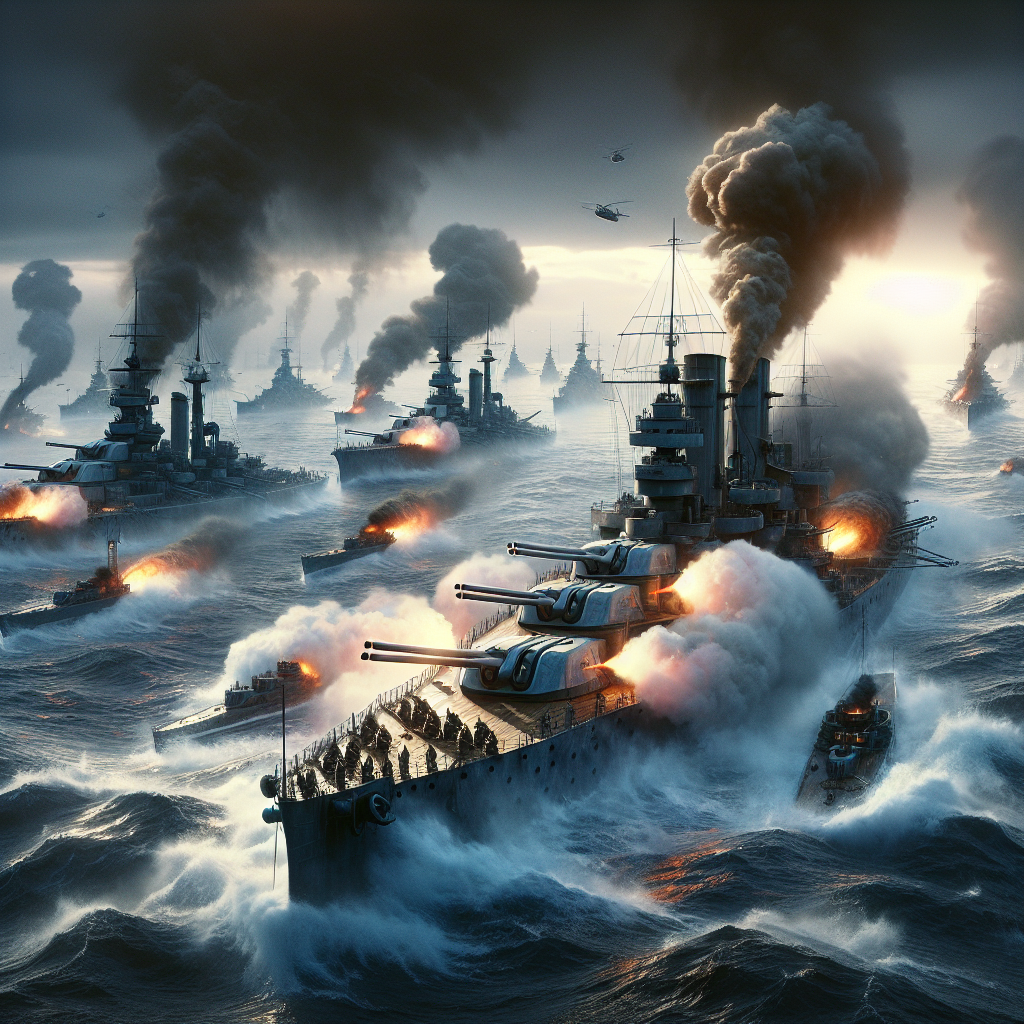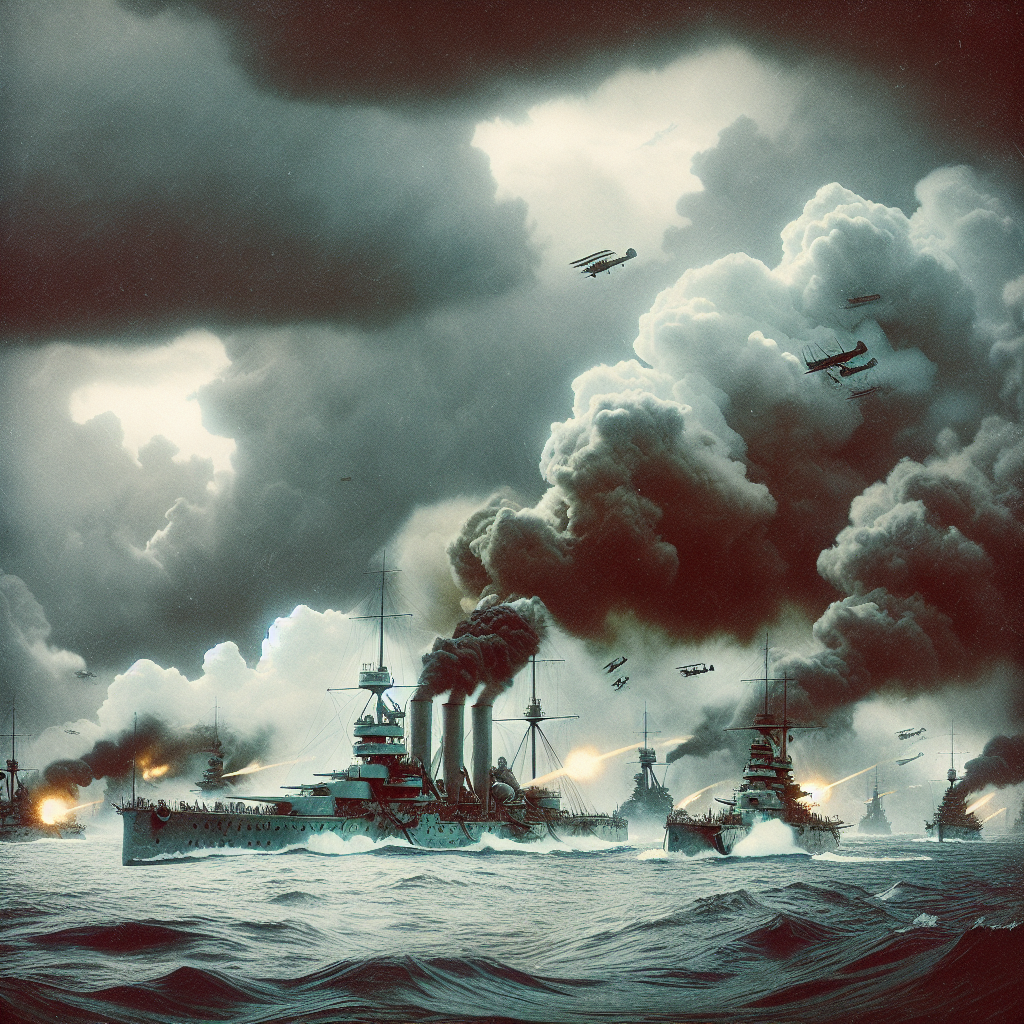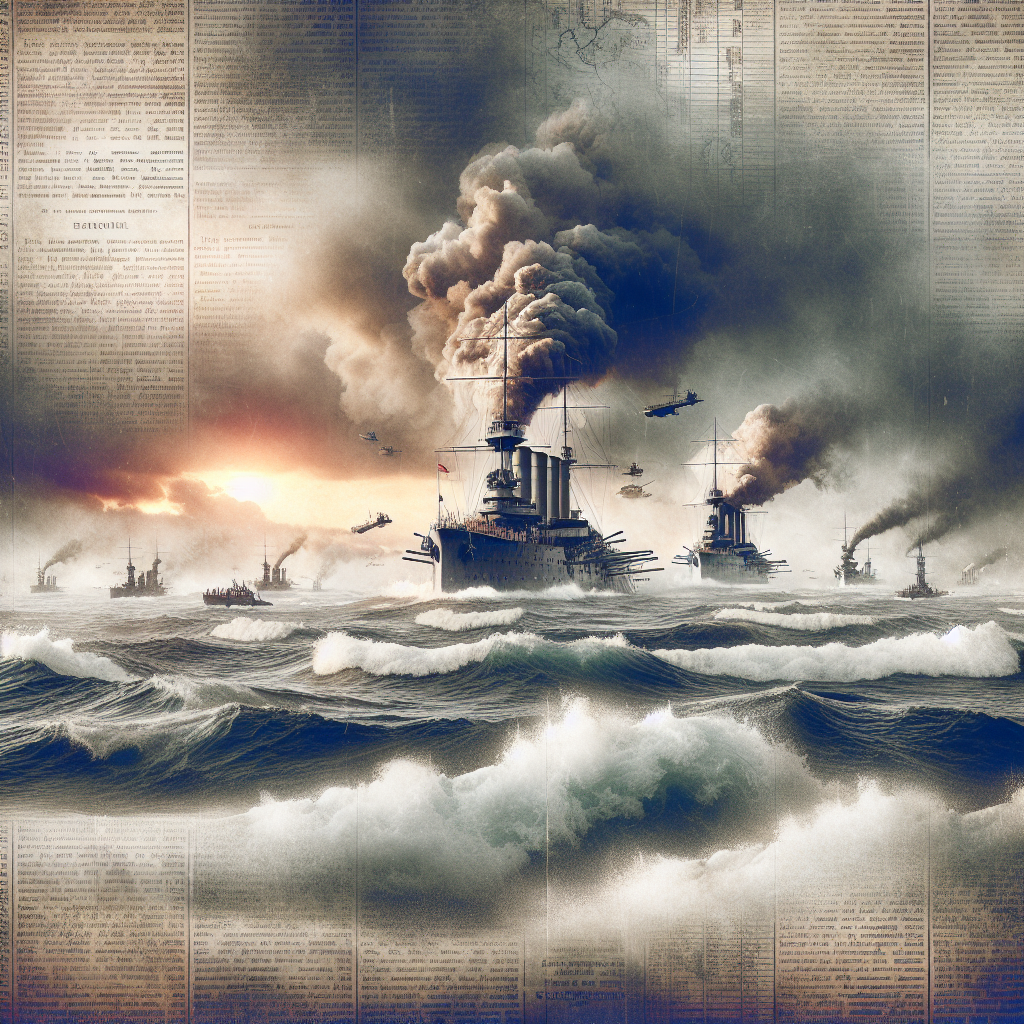The Russo-Japanese War of 1904-1905 was a conflict that not only reshaped the power dynamics in East Asia, but also witnessed some of the most epic naval battles in modern history. In this historical analysis, we delve into the heart-pounding engagements that took place on the high seas between the Russian and Japanese fleets. From the dramatic Battle of Tsushima to the daring raids at Port Arthur, these encounters showcased the technological advancements and strategic brilliance of both sides. Join us as we unravel the intense naval warfare that defined this pivotal moment in global history.
The Prelude to Conflict

In delving into the historical origins of the Russo-Japanese War, it becomes evident that a complex interplay of factors set the stage for the epic naval battles that would ensue between these two formidable powers.
Factors leading to the Russo-Japanese War
The roots of the conflict can be traced back to the late 19th century when both Russia and Japan were vying for dominance in East Asia. Tensions escalated as Russia sought to expand its influence in the region, particularly in Manchuria and Korea, encroaching upon territories that Japan considered within its sphere of influence. This clash of imperial ambitions laid the groundwork for the inevitable showdown between the two nations.
Territorial disputes
Central to the escalating tensions were the territorial disputes over strategic areas such as Port Arthur and the Liaodong Peninsula. Both Russia and Japan coveted these territories for their geopolitical significance and access to vital maritime trade routes. The contest for control over these coveted lands became a focal point of contention, fueling the flames of conflict between the two rivals.
Strategic interests in East Asia
The Russo-Japanese War was not merely a territorial dispute but a reflection of broader strategic interests at play in East Asia. Both nations sought to assert their dominance in the region, with Japan aiming to solidify its position as a regional power and Russia looking to expand its imperial reach. The clash of these strategic interests set the stage for a momentous confrontation that would reshape the balance of power in the region.
Military build-up by both nations
As tensions simmered and the specter of conflict loomed large, both Russia and Japan embarked on significant military build-up efforts. Naval modernization programs were initiated, with both powers seeking to bolster their fleets and enhance their naval capabilities in preparation for a potential showdown at sea. The escalation of military preparations on both sides underscored the gravity of the situation and foreshadowed the epic naval battles that would unfold in the waters of the Far East.
The Battle of Port Arthur
The Battle of Port Arthur marked the initial engagement between the Russian and Japanese fleets, setting the stage for a series of decisive naval conflicts during the Russo-Japanese War. Both sides employed intricate strategies in a bid to gain supremacy over the waters in the region.
-
Strategies Employed by Both Sides: The Russian fleet, stationed at Port Arthur, faced a formidable challenge from the Japanese forces. The Japanese, led by Admiral Togo, utilized a combination of aggressive tactics and innovative naval maneuvers to outmaneuver the larger but less agile Russian fleet. On the other hand, the Russians, under the command of Admiral Makarov, sought to defend their position and protect the strategically vital Port Arthur naval base.
-
Significance of the Battle in the Context of the War: The Battle of Port Arthur was of paramount importance in shaping the course of the Russo-Japanese War. It demonstrated the effectiveness of Japanese naval tactics and highlighted the vulnerabilities of the Russian naval forces. The outcome of this battle had far-reaching implications for the subsequent naval warfare in the region.
-
Outcome and Its Impact on the Subsequent Naval Warfare: The Battle of Port Arthur culminated in a decisive victory for the Japanese, who succeeded in crippling a significant portion of the Russian fleet. This victory not only bolstered Japanese morale but also underscored the need for the Russian forces to reassess their naval strategies. The impact of this battle reverberated throughout the conflict, influencing future naval engagements and shaping the overall outcome of the war.

The Russo-Japanese War was a pivotal conflict that showcased the importance of naval power in shaping geopolitical outcomes and highlighted the need for strategic innovations and adaptations in modern warfare. The lessons learned from the epic naval battles of this war influenced future naval conflicts and shaped military doctrines for years to come.
The Battle of the Yellow Sea
The Battle of the Yellow Sea, fought on August 10, 1904, was a pivotal naval confrontation between the Russian and Japanese fleets during the Russo-Japanese War. This epic battle showcased the strategic naval capabilities and technologies employed by both sides in a bid for maritime supremacy in the region.
Naval Tactics and Technologies Utilized
- The Japanese fleet, under the command of Admiral Togo, employed aggressive tactics such as crossing the Russian “T” to maximize firepower and maneuverability.
- Russian Vice Admiral Rozhestvensky’s fleet utilized more traditional line formations, which proved to be less effective against the dynamic Japanese tactics.
- Both sides utilized a combination of battleships, cruisers, and destroyers, showcasing advancements in naval technology and firepower.
Role of Admiral Togo and Vice Admiral Rozhestvensky
- Admiral Togo’s strategic acumen and bold leadership were instrumental in securing a decisive advantage for the Japanese fleet.
- Vice Admiral Rozhestvensky, while facing logistical challenges and internal discord within the Russian fleet, attempted to maneuver his forces effectively but was ultimately outmaneuvered by the Japanese.
Implications of the Battle on the Overall War Effort
- The Battle of the Yellow Sea resulted in a strategic victory for Japan, weakening the Russian naval presence in the region and bolstering Japanese control over key maritime routes.

- This victory set the stage for further naval engagements, shaping the course of the Russo-Japanese War and ultimately influencing the outcome of the conflict.
The Battle of Tsushima
The Battle of Tsushima stands out as the decisive naval engagement of the Russo-Japanese War, showcasing the pinnacle of naval warfare in the early 20th century.
Factors leading to the confrontation
The tensions between Russia and Japan had been escalating over conflicting territorial ambitions in East Asia, particularly in Korea and Manchuria. The Russo-Japanese rivalry intensified, leading to a naval arms race as both nations sought to assert dominance in the region. The breaking point came with the Port Arthur incident, where the Russian Baltic Fleet sailed to the Far East to reinforce the Russian presence, sparking a direct confrontation with the Japanese fleet.
Comparison of the naval forces
The Battle of Tsushima pitted the Russian Baltic Fleet, led by Admiral Zinovy Rozhestvensky, against the formidable Japanese Combined Fleet under the command of Admiral Togo Heihachiro. The Russian fleet, comprising outdated and poorly maintained vessels, faced off against the modern and well-coordinated Japanese warships. The technological superiority of the Japanese fleet, coupled with their strategic positioning, gave them a significant advantage over the Russian forces.
Impact of the battle on the outcome of the war
The resounding victory of the Japanese at the Battle of Tsushima had far-reaching consequences for the outcome of the Russo-Japanese War. The defeat dealt a severe blow to Russian naval power and effectively ended any hopes of Russian dominance in East Asia. The loss of the Baltic Fleet not only tilted the balance of power in favor of Japan but also contributed to internal unrest in Russia, eventually leading to the signing of the Treaty of Portsmouth and the formal end of the war.
The Aftermath of Naval Warfare
- Effects of the naval battles on the course of the Russo-Japanese War
The naval battles of the Russo-Japanese War significantly influenced the course of the conflict. The Japanese victory at the Battle of Tsushima, where they virtually decimated the Russian Baltic Fleet, marked a turning point in the war. This decisive naval victory allowed Japan to assert dominance over the seas and secure control over key strategic locations in the region. The Russian defeat highlighted weaknesses in their naval capabilities and forced them to reassess their military strategies.
- Diplomatic repercussions
The naval battles of the Russo-Japanese War had far-reaching diplomatic repercussions. The defeat of the Russian navy not only impacted the outcome of the war but also had implications for international relations. The defeat of a major European power by an Asian nation challenged existing notions of global power dynamics. It also led to increased diplomatic tensions between Russia and other major powers, particularly impacting their relations with Japan and the United States.
- Shifts in global power dynamics
The naval battles of the Russo-Japanese War resulted in significant shifts in global power dynamics. Japan’s unexpected victory over Russia established Japan as a formidable naval power and signaled its emergence as a major player on the world stage. The defeat of Russia, a traditional European power, by an Asian nation, challenged existing power structures and paved the way for the rise of Japan as a dominant force in the region. This shift in power dynamics had lasting implications for international relations and military strategy.
- Legacy of the naval engagements in military history
The naval battles of the Russo-Japanese War left a lasting legacy in military history. The strategies and tactics employed during these battles, particularly at Tsushima, influenced naval warfare for decades to come. The use of torpedo boats, long-range gunnery, and coordinated fleet maneuvers showcased the importance of naval power in modern warfare. The lessons learned from these engagements shaped future naval doctrines and influenced military thinking around the world. The legacy of these naval battles continues to be studied by military historians and strategists seeking to understand the evolution of naval warfare.
Lessons Learned and Historical Significance
- Analysis of the naval strategies employed by Russia and Japan
The Russo-Japanese War revealed contrasting naval strategies between the two powers. Russia, with its Baltic Fleet, faced challenges in coordinating its forces over long distances, leading to strategic disadvantages. In contrast, Japan’s concentrated approach emphasized swift and decisive action, utilizing its superior speed and maneuverability to outmaneuver the Russian fleet.
- Military innovations and adaptations during the war
During the conflict, both Russia and Japan implemented innovative tactics and technologies to gain an edge in naval warfare. Japan’s effective use of torpedoes and mines showcased the importance of asymmetrical warfare in naval battles. Russia, on the other hand, struggled to adapt its traditional tactics to the changing dynamics of modern naval combat, highlighting the need for flexibility and innovation in military strategies.
- Influence of the Russo-Japanese War on future naval conflicts
The Russo-Japanese War marked a significant shift in the global balance of power, signaling the rise of Japan as a formidable naval force and the decline of Russia’s naval influence. The lessons learned from this conflict, particularly in terms of the importance of agility, technological advancements, and strategic planning, would shape the development of naval doctrines in future conflicts, including World War I and World War II.
- Reflections on the enduring impact of the naval battles
The epic naval battles of the Russo-Japanese War left a lasting impact on the course of naval history. The Battle of Tsushima, in particular, demonstrated the decisive nature of naval engagements and the potential for a well-executed naval strategy to shift the tides of war. This conflict underscored the significance of naval power in shaping geopolitical outcomes and emphasized the need for continuous innovation and adaptation in naval warfare to secure victory on the high seas.
FAQs – Russo-Japanese War Naval Battles
What were the key naval battles of the Russo-Japanese War?
The Russo-Japanese War saw several significant naval battles, including the Battle of Port Arthur, the Battle of the Yellow Sea, the Battle of Tsushima, and the Battle of the Sea of Japan. These battles were fought between the navies of Russia and Japan in the early 20th century and played a crucial role in shaping the outcome of the war.
What was the significance of the Battle of Tsushima?
The Battle of Tsushima was a pivotal naval battle in the Russo-Japanese War, fought on May 27-28, 1905. The Japanese fleet, under the command of Admiral Togo Heihachiro, decisively defeated the Russian fleet, leading to the near-total destruction of the Russian navy. The Japanese victory at Tsushima established Japan as a major naval power and played a key role in forcing Russia to sue for peace.
How did technology impact the naval battles of the Russo-Japanese War?
The Russo-Japanese War marked a turning point in naval warfare, as it showcased the importance of technologies such as wireless communication, long-range artillery, and torpedo boats. Both sides utilized new naval tactics and strategies, leading to innovative engagements that would influence naval warfare for decades to come.
What were the lasting effects of the naval battles of the Russo-Japanese War?
The naval battles of the Russo-Japanese War had far-reaching consequences, including the rise of Japan as a formidable naval power, the decline of the Russian navy, and the reshaping of the balance of power in East Asia. The war also highlighted the importance of naval supremacy in modern warfare and set the stage for future conflicts in the region.
0 Comments